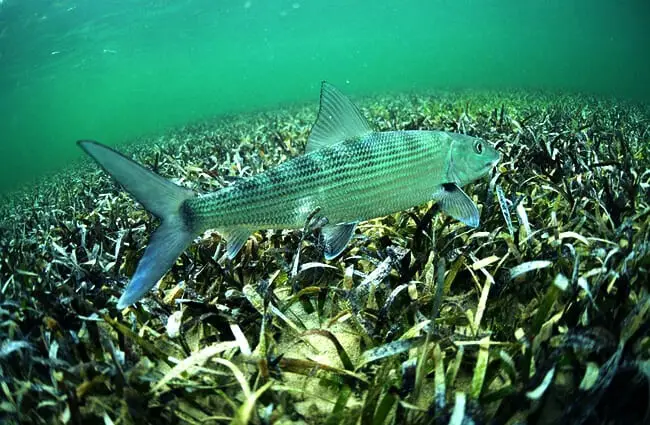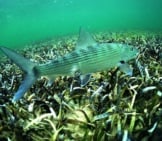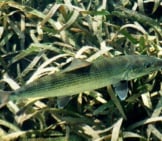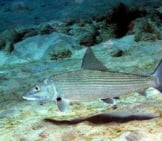The Bonefish is a medium sized fish in the Albulidae family that lives in the Atlantic and South Pacific oceans. Researchers recognize 11 different species within the family. For our purposes, we will focus on the most common and well known of the various species, Albula Vulpes. Read on to learn about the Bonefish.
Description of the Bonefish
This species has a typical “fish-like” appearance. It has an elongated, torpedo-shaped body with silvery scales. The rostrum, or snout, is rather pointed in appearance. The top, or dorsal, fin has a triangular shape similar to that of a shark.
Adults typically measure about 1.5 ft. long, but larger individuals reach lengths of 3.25 ft. or more. Most weigh about 6 lbs. on average, but some reach weights up to 19 lbs. As adults, females grow larger than males.
Interesting Facts About the Bonefish
Like the tarpon, this species is a quite popular game fish. Learn what else makes this fish so unique, below.
- Relatives – Not only does this fish share a “popular” status in the fishing world with tarpons, but it also shares a bloodline. The closest relatives of the Albulidae family include the tarpons and ladyfishes.
- Migration – When you picture a migration, you might imagine a bird flying from one continent to another, or a sea turtle crossing the ocean. This species makes short daily migrations. It follows the tide from coastal waters to the shallow mudflats to hunt for food.
- Bonefishing – People enjoy fishing for this species so much that they have given the sport its own name, Bonefishing! However, most people do not enjoy the taste of this fish, so they often employ catch and release methods.
Habitat of the Bonefish
During different times of day these fish occupy different types of habitats. When they are not hunting for food, they live in deeper waters, down to about 300 ft. or so. As the tide comes in, the fish swim up into the shallow mudflats to search for food. You can find them in waters as shallow as 4 in. deep!
Distribution of the Bonefish
This species lives throughout portions of the Atlantic Ocean, Gulf of Mexico, and the Caribbean Sea. Its range extends from southern Florida through the Bahamas, Cuba, and the surrounding islands. From there, it extends to northern South America and along the coasts to Central America and southern Mexico.
Diet of the Bonefish
These fish are carnivores, which means that they eat other animals. They hunt primarily in the shallow mudflats, feeding on crabs, shrimp, small fish, and various invertebrates like worms and snails. When they are hunting, they break off on their own, in pairs, or in small groups to search for prey.
Bonefish and Human Interaction
As discussed previously, humans target this fish species as a sport fish. In some regions they do eat the fish, but for the most part they utilize catch and release. However, this activity weakens the fish and has aggravated in population decline.
Though fishing results in some harm, habitat destruction and climate change pose a much greater risk to this species. The mangroves, seagrasses, and mudflats that this fish hunts in all suffer due to human activity, pollution, and climate change. The IUCN lists this species as Near Threatened.
Domestication
Humans have not domesticated this fish in any way.
Does the Bonefish Make a Good Pet
No, this species doesn’t make a good pet. Though they do not reach extensive lengths, people do not often keep this species in home aquariums. They move about quite a bit in a given day, and must have extensive tanks for comfortable living.
Bonefish Care
Many aquariums house this species, particularly in the southeast United States where they are popular game fish. They keep the fish in large habitats with a variety of underwater vegetation and often real or artificial mangroves. Aquarists feed them shrimp and other crustaceans, along with small fish.
Behavior of the Bonefish
This social species lives in schools. When the tide is out, they retreat to deeper waters and remain in large numbers. It is not unusual to spot schools of 50 or 75 fish in deeper areas. However, as the tide comes in, they swim into shallow mudflats and seagrass beds to hunt for prey. While hunting they break off on their own or in small groups.
Reproduction of the Bonefish
These fish breed seasonally, often in spring and summer. They breed through spawning, where the females release their eggs into the water and the males release sperm to fertilize them.
The females release their eggs into the open water rather than depositing them on vegetation. After hatching, it takes at least three or four years for the fish to reach sexual maturity.











![Red Angus Closeup of a beautiful Red Angus cowPhoto by: U.S. Department of Agriculture [pubic domain]https://creativecommons.org/licenses/by/2.0/](https://animals.net/wp-content/uploads/2020/03/Red-Angus-4-238x178.jpg)












![Red Angus Closeup of a beautiful Red Angus cowPhoto by: U.S. Department of Agriculture [pubic domain]https://creativecommons.org/licenses/by/2.0/](https://animals.net/wp-content/uploads/2020/03/Red-Angus-4-100x75.jpg)

